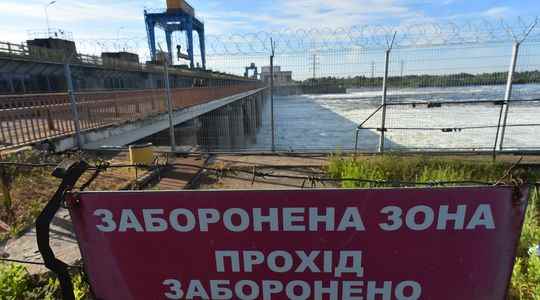The Kakhovka hydroelectric dam, located on the Dniep River in southern Ukraine, was one of the priority targets of the Russian army at the start of the invasion of its neighbor. Falling into the hands of Moscow on February 24, this highly strategic infrastructure, built in 1956 during the Soviet period, is 16 meters high, 3,850 meters long, and notably allows water to be sent into the Crimean Canal from North, which starts from the south of Ukraine and crosses the entire Crimean peninsula. However, Thursday, October 20, Volodymyr Zelensky accused the Russian forces of having “undermined” the dam and the units of the power station.
- What would be the damage in case of destruction?
“In case of destruction of the dam (…) the North Crimean Canal will simply disappear”, and it would be “a large-scale disaster” warned the Ukrainian president. “More than 80 localities, including the city of Kherson, will find themselves in the zone of rapid flooding”, he was alarmed before the Council of the European Union. Its destruction “could destroy the water supply of a large part of southern Ukraine”, and affect the cooling of the reactors of the Zaporizhia nuclear power plant, the largest in Europe.
On Friday, Ukraine therefore called on “the UN, the EU and other organizations to organize an international observation mission” within this power station which represents a crucial stake. Both kyiv and Moscow could have an interest in using the building to tip the conflict in the region. The Russian occupation authorities in Kherson deny, for their part, any mining of the Kakhovka dam.
- Why would Russia want to destroy the dam?
Kakhovka is, as the crow flies, 60 km east of Kherson, the first major city to fall into Russian hands in March. While the Russian army has begun to evacuate it in the face of advancing Ukrainian troops, kyiv fears that Moscow is seeking to destroy the dam to cover a possible retreat from the city. The goal of Russia would be to stop the advance of Ukrainian troops in the region and to protect the Russian forces, estimated on Twitter one of the advisers to the presidency, Mykhaïlo Podolyak.
It is impossible today to verify the claims of the Ukrainians and Russians. According to an analysis note published Wednesday, October 19 by the American think tank ISW (Institute for the Study of War), Russian sources accuse Ukrainian forces of bombing the hydroelectric plant and widely broadcast animations describing flood zones in the event of a dam failure. One of the possible objectives: to prepare the ground for an attack on the dam of the Kakhovka hydroelectric power station and to impute responsibility for it to the Ukrainians.
- What is the situation in Kherson?
In September, Ukraine launched a counter-offensive in the Kherson region, west of the Dnieper. Since then, Ukrainian soldiers have been gradually pushing back Russian forces near the dam and the city of Kherson itself, which has – among other things – prompted Vladimir Putin to declare the partial mobilization of its population. Last Tuesday, the new commander of the Russian forces in Ukraine, Sergei Surovikin, recognized a “tense” situation on the front. “The enemy is not giving up its attempts to attack Russian troop positions,” he said.
The Russian occupation administration in Kherson meanwhile said on Wednesday that it had launched the evacuation of civilians from the city in the face of advancing Ukrainian troops, while assuring that the Russian army would fight on the spot “until death”. Moscow expects an imminent arrival of Ukrainian forces on the outskirts of the city.
